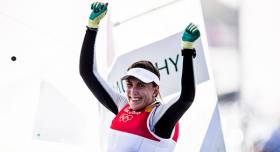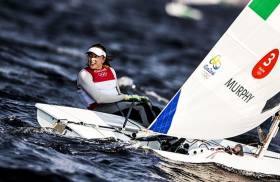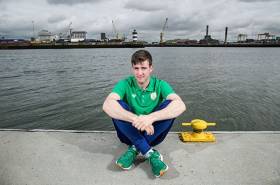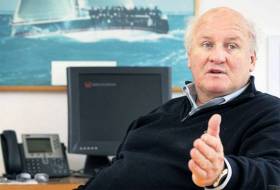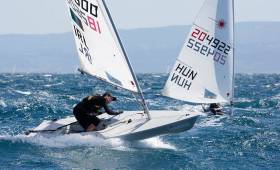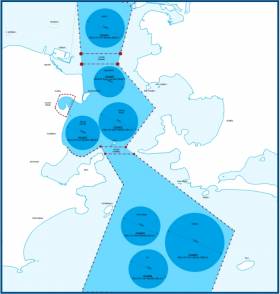Displaying items by tag: Olympic
Sweet Rio-demption
A fourth place in her first Olympic campaign,
Left Annalise heartbroken, she couldn't hide the pain.
But our Irish Laser Radial Queen,
Immediately focused on twenty sixteen,
Brushed herself off and got back on her feet,
Showed the world she was more than that London defeat.
While the road to Rio wasn’t smoothly paved,
Murphy's passion and drive could not be waived.
Four years training in both sunshine and hail,
Perfecting her technique for the tricolour sail.
She started in Rio - a bullet in race one,
Irish hopes soared as her Olympic series begun.
Consistently staying in the top 3 all week,
Had us all on the edge of our tracker following seats.
Then it came to the final medal race day,
But bad weather postponed events in Guanamara Bay.
Murphy kept her cool for one more sleep,
While the nerves of her nation were all in a heap.
On Tuesday the light Rio sea breeze filled in,
allowing the Radial medal race to begin.
Three Olympic medals, five boats in the mix,
Murphy guaranteed Bronze with a finish ahead of boat six.
On the first leg Murphy magic began to spark,
Second place around the windward mark!
As Annalise sailed the course she made us even prouder,
Shouts at the TV back home got louder and louder.
Then she crossed the finish line with a big grin,
This time she'd done it - a silver medal win.
A 36 year medal drought in the bin,
Thanks to Annalise Murphy our Irish Sailing Olympian.
by Sharon Quigley
With yesterday’s fourth day of sailing for the Women’s Laser Radials at the Rio Olympics bedevilled by light breezes after unusually strong winds earlier in the week, pressure is intensified on Annalise Murphy, who has electrified everyone at home with an inspirational performance. Although she slipped from the lead to third overall after recording an 18th in yesterday’s first race in light conditions, she saw an improvement in the second contest (Race 8) to take 12th and continue in a clearer third place overall. W M Nixon takes a look at the family background which has provided the foundations for this world class sailor, and analyses how our Olympic sailing history has made the hope for a medal almost a national obsession.
Olympic sport is a matter of intensely private effort made under an unprecedented level of global scrutiny. And Olympic sailing can seem like a particularly exquisite form of torture, as it manages to combine the toughest elements of the sprint with the marathon.
The sprint side is obvious. The races of the 2016 Olympiad can seem almost absurdly short to the observer, even if they seem long enough to the participants, particularly those who have carved out a lead. But the insidious marathon side is to be found in the overall length of time the entire series takes up. Days and days. It’s like war. Brief periods of intense excitement and activity, separated by long periods – day after day - of waiting. Boredom could become an enemy for the psychologically unprepared.
In sailing in particular, the complexity is total. This vehicle sport, in which the mysterious wind is the driving power, and on an unpredictable sea at that, is a severe test for athletic ability, technological savvy, tactical and strategical techniques, and the most profound depths of psychological inner strength.
Even in a normal sailing area, that’s how sailing is. But the sailing in Rio is heroically abnormal. In fact, for the first five days of the Sailing Olympiad 2016, it could be argued that the sailing conditions are the unpredictable stars of the show. Offshore breeze with smooth water? Then you can get little bullets of wind curving round those crazy peaks to have one boat planing along while another well within shouting distance is just plodding. Strong onshore winds? They don’t mess about – these are winds, they’re not breezes, and on the most seaward course area at Copacabana, the result can be waves as big as house.
And then yesterday came light airs. So those who are doing well are those who are keeping themselves unfazed by the kaleidoscope of sailing conditions. And as Annalise Murphy has made no less than nine prolonged sailing visits to the race area in the three and more years since she shook off the upset of suddenly dropping out of the medals at the London Games of 2012 in the final Medals Race itself, Rio is almost a home from home, and she knows its wayward ways
But inevitably as she comes within striking distance of a medal in Rio, everything is magnified. But not in any panoramic way. We’re talking microscopic magnification here. Her every move, every facial expression, every statement, is minutely dissected and analysed.
A fortnight ago here, in trying to set the scene, we gave an impression of the team as they prepared to depart for Rio:
“So how are our sailors going to do in Rio? As Annalise Murphy has more experience of the venue than anyone else, her opinions were of special interest. She crisply dismissed any grumblings about the flukiness of the sailing waters by saying that the unpredictability is so general in sailing in Rio’s winter (or what passes for winter when you’re near enough to the equator) that in the end it’s the same for everyone.
Certainly she’s giving it her best shot, and she has benefitted – as have all the Irish sailing squad - from the involvement (intensive in her case) of uber-coach Gary Keegan of the Institute of Sport. He’s leaving the Institute for a new venture after the Olympics, but for now, he has helped guide Murphy to peak form, thanks to a closely-controlled weight reduction programme as part of a carefully-monitored training plan which, at Tuesday’s conference, had the Irish sailor looking extremely fit and well, with her mental outlook in a very good place.”
The Annalise Murphy who went off to the Olympics less than a fortnight ago was a very different person from the frustrated sailor who was disappointed with her own international performances early in the season. There’ll be time enough, once these Olympics are over, to learn about how the transformation was brought about in such a relatively short time. But some hints of the psychological adjustments which have been made came through from various sources.
In her interviews this week, as the mesmerizing saga of her consistency at the top of the Women’s Laser Radial leaderboard has unfolded to capture the national imagination, one of her comments stands out. She has said several times – indeed, many times – that she’s enjoying herself. Ally that with her determination to take it one race at a time, together with her new extra-trim fitness levels, and in all, Ireland has a formidable presence among the pace-setters in her class.
It speaks volumes for her strength of character, which in turn speaks volumes for the family background from which she has emerged. But then, when you have parents like Con Murphy and Cathy McAleavey, the likelihood of your own sailing being something special is very high indeed.
Con and Cathy were pioneers in multi-hull sailing in Ireland, and then Cathy pioneered in another direction by teaming up with Aisling Byrne to race the 470 for Ireland in the 1988 Olympics, the first Olympics with a specifically women’s class.
 Cathy McAleavey and her daughter Annalise Murphy racing the family’s Water Wag in the Volvo Dun Laoghaire Regatta. Photo VDLR
Cathy McAleavey and her daughter Annalise Murphy racing the family’s Water Wag in the Volvo Dun Laoghaire Regatta. Photo VDLR
Cathy has since become a tower of strength in the classic boat movement with new boats for the Water Wag and Shannon One Design classes built with the great Jimmy Furey of Roscommon, but for many years before that she was a serious competitor in the Lasers. Yet it was the Holy Grail of the Round Ireland Sailing Record which really brought Con and Cathy into the limelight way back in 1993, when they persuaded Steve Fossett to bring his 60ft trimaran Lakota to Ireland for a record challenge in September. It was a challenge in which Con and Cathy were key members in the crew, a challenge so perfectly calculated that their record time stood for 22 years.
Thus there was a satisfying completeness to the global sailing scene as it impinged on their home club of the National Yacht Club last night, for not only were members gathered to cheer Annalise on her way as she sailed races 7 and 8 of the Rio Olympics, but American speed sailor Lloyd Thornburg was back in town to embrace the trophy which he so recently won with Phaedo 3’s new Round Ireland record, a trophy which first appeared when the Lakota record was set back in 1993.
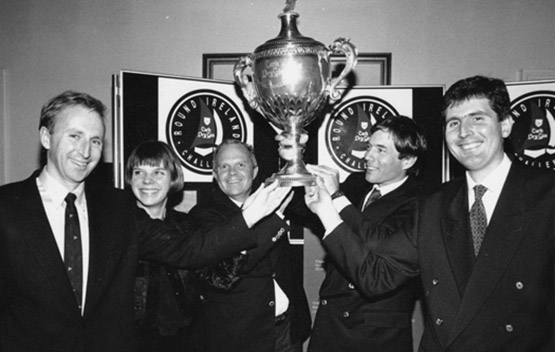 The crew of Lakota in the National Yacht Club after her Round Ireland Record in 1993 are (left to right) Con Murphy, Cathy McAleavey, Steve Fossett, Dave Scully, and Brian Thompson who currently sails with Lloyd Thornburg on Phaedo 3.
The crew of Lakota in the National Yacht Club after her Round Ireland Record in 1993 are (left to right) Con Murphy, Cathy McAleavey, Steve Fossett, Dave Scully, and Brian Thompson who currently sails with Lloyd Thornburg on Phaedo 3.
As for Irish involvement in the sailing Olympics, it goes back only to 1948, as it had taken some time since Irish Independence in 1921 to establish a separate Irish national sailing identity. In fact for some time to come, most contentious sailing matters were still to be referred to the Yacht Racing Association in London, which became the Royal Yachting Association in 1953).
But for the Olympics in 1948, an ad hoc organization called the Irish Yachting Federation was established to be the required national authority. Thereafter, the Irish Dinghy Racing Association (subsequently the Irish Yachting Association, and now the ISA) took over the role, but today in seeing Ireland contemplate medal territory, it’s timely to salute those who sailed for Ireland in the Olympic cause in times past, for as late starters in the Olympic sailing game, we have an extra edge to our medal hunger. And we can also reflect on the huge changes in boat type used.

IRISH OLYMPIC SAILING REPRESENTATION, 1948-2016
1948 - London (Torquay)
Firefly: Jimmy Mooney
Swallow: Alf Delaney, Hugh Allen
Reserve: D St J Sullivan
Management: Billy Mooney, Errol McNally
1952 - Helsinki
Finn: Alf Delany
1956 Melbourne
Finn: J. Somers Payne
1960 Rome
Flying Dutchman: Johnny Hooper, Peter Gray
Dragon: Jimmy Mooney, David Ryder, Robin Benson
Finn Class: J. Somers Payne
Reserve: Neil Hegarty
Management: Clayton Love Jnr, Alf Delaney
Boatman: Jimmy Miller
1964 Tokyo
Dragon: Eddie Kelliher, Harry Maguire, Rob Dalton
Finn: Johnny Hooper
Manager: Leo Flanagan
1968 Mexico City - Sailing in Acapulco
No competitors
1972 Munich - Sailing in Kiel
Tempest: David Wilkins, Sean Whitaker
Dragon: Robin Hennessy, Harry Byrne, Owen Delany
Finn: Kevin McLaverty
Flying Dutchman: Harold Cudmore, Richard O'Shea
Reserves: Curly Morris, Joe McMenamin
Management: Peter Gray, Ken Ryan, Kare Brevik
1976 Montreal - Sailing in Kingston
470: Robert Dix, Peter Dix
Flying Dutchman: Barry O'Neill, Jamie Wilkinson
Tempest: David Wilkins, Derek Jago
Management: Ken Ryan, Jock Smith
1980 Moscow - Sailing in Talinn
SILVER MEDAL
Flying Dutchman: David Wilkins, Jamie Wilkinson
Management: Michael Maguire, Tom Clancy
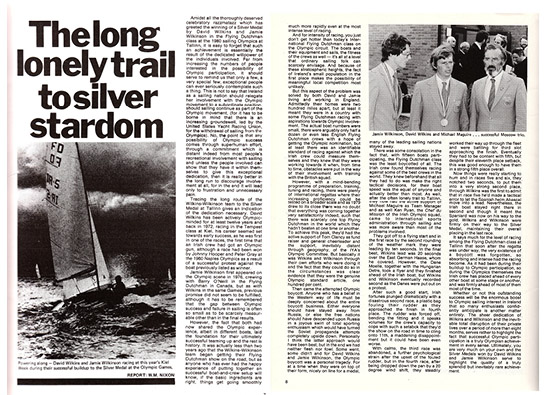 The magic moment – Afloat report on 1980’s Silver Medal
The magic moment – Afloat report on 1980’s Silver Medal
1984 Los Angeles
Finn: Bill O'Hara
Management: Mick Wallace
1988 Seoul - Sailing in Pusan
Finn: Bill O'Hara
Flying Dutchman: David Wilkins, Peter Kennedy
470(Women): Cathy MacAleavy, Aisling Byrne
Reserves: Maeve McNally, Conrad Simpson
Management: Michael Wallace, Con Murphy
1992 Barcelona
Europe: Denise Lyttle
Flying Dutchman: David Wilkins, Peter Kennedy
Star: Mark Mansfield, Tom McWilliam
Reserves: Denis E O'Sullivan, Conrad Simpson
Management: Michael Wallace, Mark Lyttle, Trevor Millar
1996 Atlanta - Sailing in Savannah
Laser - Mark Lyttle
Europe - Aisling Bowman(Byrne)
Finn - John Driscoll
Star - Mark Mansfield & David Burrows
470 (Women) - Denise Lyttle & Louise Cole
Soling - Marshall King, Dan O'Grady & Garrett Connolly
Management - Derek Jago, Paddy Boyd, Anne Blaney and Bill O'Hara
2000 Sydney
Europe - Maria Coleman
Finn - David Burrows
Star - Mark Mansfield & David O'Brien
Management - Bill O'Hara, James Hynes, Garrett Connolly, Paddy Boyd, Anne Blaney
2004 Athens
Europe - Maria Coleman
Finn - David Burrows
Star - Mark Mansfield & Killian Collins
49er - Tom Fitzpatrick & Fraser Brown
470 - Gerald Owens & Ross Killian
Laser - Rory Fitzpatrick
Management - Garrett Connolly
2008 Qingdao
Star - Peter O'Leary & Stephen Milne
Finn - Tim Goodbody
Laser Radial - Ciara Peelo
470 - Gerald Owens & Phil Lawton
Management - James O'Callaghan
2012 London sailing at Portland/Weymouth
Star - Peter O'Leary & David Burrows
Laser Radial - Annalise Murphy
49er - Ryan Seaton & Matt McGovern
Laser - James Espey
470 - Ger Owens & Scott Flanigan
2016 Rio de Janeiro
Laser Radial – Annalise Murphy
49er – Ryan Seaton & Matt McGovern
Laser – Finn Lynch
49erFX – Andrea Brewster & Saskia Tidey
The International Star was the unlikely provider of the last gasp for keelboats, and that was in the 2012 Olympics. Although the Stars still harbour hopes that they will get a call to return to the five ring circus, no-one else sees keelboats happening again in the line–up, as the athletic approach to sailing takes over completely.
As it is, involvement with the Olympics can knock a class off course completely, and over the 120 years of Olympic sailing, only a few of the boat types involved longterm have emerged unscathed. All of which resonates to the great credit of the Bruce Kirby-designed Laser. Here at last is a boat which can be both a very viable Olympic class – it has the biggest fleet at Rio – while also being a boat which succeeds for sailors at all levels. So let’s hear it for the gallant little Laser – she has risen above the Curse of the Olympics.
Meanwhile out in Rio yesterday the evening trickled away and still the quest for another medal, the first since 1980, goes on. Over the years, the level of Irish achievement has gradually risen. In 1960 when the Rome Olympics staged the sailing in Naples, we had our first race win by Peter Gray and Johnny Hooper, but that was by default as the Italian crew were disqualified after it was proven they’d left out a mark.
Thus it was 1972 at Kiel in Germany before Ireland got a race-winning gun, for David Wilkins and Sean Whitaker in the Tempest two-man keelboat. And then eight years later it was David Wilkins – our most tenacious Olympic sailor – who finally brought home the Silver Medal, crewed by Jamie Wilkinson in the Flying Dutchman, a two-man 20ft dinghy which seemed the height of modernity at the time, hut with a massively over-lapping genoa which went round the block and back again, she now seems almost quaint.
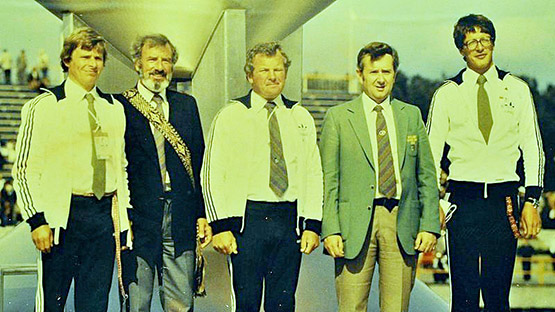 The team which took the Silver Medal in 1980 are (left to right) David Wilkins (helm), Michael Maguire (Manager), Kare Brevik (Meteorologist), Ken Ryan (Chef d’Equipe) and Jamie Wilkinson (crew)
The team which took the Silver Medal in 1980 are (left to right) David Wilkins (helm), Michael Maguire (Manager), Kare Brevik (Meteorologist), Ken Ryan (Chef d’Equipe) and Jamie Wilkinson (crew)
But yesterday’s conditions weren’t quaint. They were maddening. Racing went nowhere at first, but by the second race - Race 8 - a reasonable breeze filled in further offshore. Annalise Murphy’s 18th in Race 7 should be seen in the broader context, with Race 8’s 12th firming up her third overall. For Olympic newbie Finn Lynch in the Men’s Laser the competition piled on, and he had to be content with a 33rd in Race 7 which tested his resolve, as it puts him back to 28th overall in a series in which he was showing in the top third of the 46–strong fleet in the early races, but her finished the day 30th overall.
As for the next wave of classes now coming into their programmes, Matt McGovern and Ryan Seaton in the 49er were best, they showed a 14th for the first race, but an outstanding second in Race 2 shunted them up to fifth overall, which is definitely something to work with.
But taking the long view, a medal is a medal. After 36 years, the people are hungry and thirsty. So for now, here’s to the Flying Dutchman, which did it for us back in 1980.
The International Flying Dutchman. All of 20ft long, and with a genoa only for heroes. But she brought home the Silver for Ireland in 1980
Annalise Murphy has finished 18th in race seven and dropped to third in the overall standings. The race, her worst result of the regatta so far, was a struggle in eight to 12 knots but the Dubliner will be boosted by a great light air comeback over taking 10 boats on the second round of the Laser Radial course to get back into the teens in the 37–boat fleet. Race eight follows.
Overall top ten below after seven:

There's another couple of 12–knot races in prospect for Annalise Murphy in the Olympic Laser Radial class today. But after that all similarities will end for the sailors as today's races five and six are on the Copacabana course which is outside the bay and at sea. It's a crucial stage as the regatta passes the half–way stage. The race area is subject to tidal conditions and winds are expected to be different to anything seen on the first two days, perhaps a little more like Annalise's home waters of Dublin Bay?
Annalise has been training in Rio on at least ten occasions over the past four years and will be familiar with all the course locations being sailed this week.
Start time is 5:10 Irish time. No TV coverage again.
Rio Storm Before Olympic Sailing Starts, Moderate Winds for First Laser Races Forecast
As Irish Laser sailors Annalise Murphy and Finn Lynch, both of the National Yacht Club, prepare for their first race of the Olympic regatta later today, the Olympic sailing venue saw 40 knots of wind blast out of nowhere and hit the sailing race track from the south-west. With sand whipping across Flamengo Beach, it was an eye-watering reminder that in Rio, you really do have to be prepared for anything. An Angolan 470 ventured out for some high-wind practice, but no one else was showing much interest. With less than 24 hours before the RS:X Men and Women kick off the Olympic Sailing Competition, along with the Laser and Laser Radial, this was not the right time in the four-year cycle for putting bodies and equipment in jeopardy.
Chang Hao is representing Chinese Taipei in the RS:X Men. "My plan was to go sailing today but the wind was too strong so I am just relaxing. I'll set up my equipment and go back to the apartment and take some rest. My first Olympics was 2008, when I was 17. This is my third Olympics, so I'm getting old. But I hope I can go to five Olympics, that's my dream. This time the sailing is close to the city, which is great. I hope i can go and watch other sports, the rugby, the cycling maybe.”
Later on in the afternoon the breeze dropped away to almost nothing. The calm after the storm. The forecast for Monday and the first day of competition looks favourable, with moderate winds and sunny skies on the cards. It could be a perfect way to get things started and calm the nerves after all the tension, the hype and the build-up to this hotly anticipated contest. For local fans in Rio, they will be watching Robert Scheidt open his campaign in the Laser. Can the poster boy (aged 43) of Brazilian sailing write a new chapter in Olympic history and win a record sixth medal?
Meanwhile, there are those looking to make their first mark on the Olympics, such as Alisa Kiriliuk, helming Russia's entry in the women's 470. "This is my first time at the Games but I am not too nervous. My father, Andrei, went to three Olympic Games in the Laser, Soling and Tornado. He is helping me very much. His message to me is: Don't be afraid, just smile, relax, have fun and do what you normally do.”
Arantza and Begoña Gumucio have been sailing together for most of their lives and now the sisters are sailing for Chile in the 49erFX. "It's incredible to be at our first Olympics, and we are loving every moment,” said Arantza. Begoña chimes in, "We're staying in the Olympic Village, sharing a room and soaking up the atmosphere. And when we're out on the water, the local fisherman shout out 'Chile, Chile!' This feels like a home Games for us, we have the South American connection with our friends in Brazil, so we are going to enjoy this a lot.”
For most teams, the first race can't come soon enough. The Nacra 17 fleet, however, is one of the last to start. One team that might be happy about that is the Greek duo of Sofia Bekatorou and Michalis Pateniotis. "We have been sailing together as a team for just four months, so we are still in our honeymoon period,” said Bekatorou of her young partnership with Michalis Pateniotis. Every moment on the water counts for the Greek duo who are being coached by Anton Paz, winner of a gold medal in the Tornado catamaran for Spain, at the 2008 Games. Bekatorou won gold in the 470 at Athens 2004 and bronze in the Yngling at Beijing 2008. Pateniotis has yet to win an Olympic medal. "Working with Sofia it is easy to see how she has achieved so much in her career,” says Pateniotis. "When she sets a goal, she goes all out to get it. We would have liked more time to get ready but we have worked hard for the short time we have been sailing together. We are as ready as we are going to be now.”
Giles Scott was good enough to win a medal four years ago at London 2012. But the Briton had to bide his time as Ben Ainslie was selected for his fifth Olympic Games. Great Britain has won the gold medal in the Finn going back to Iain Percy's victory in Sydney 2000, so there is a sense of expectation around Scott, the four-time World Champion. "For me this moment has been a long time coming, a long old road. In a way it's odd to be so close to it. We've done a lot of hard work to get to this point, and now I just want it to get started. I've done as much research as I can into what to expect, talking to people who have been to the Games before. As of now, it's been how I expected, with more media interest, the measurement and so on, but it feels quite comfortable. Today we have seen a lot of wind. It's a reminder that you could easily have two weeks of no wind and you could easily have two weeks of 20 knots, so you really do have to be ready for everything.”
No matter how much people tell you to try and treat the Olympics is 'just another regatta', Annette Viborg of Denmark believes it's just not possible. Sailing with Allan Norregaard in the Nacra 17 Mixed Multihull, Viborg commented, "The Olympics is even more crazy and mad than I expected. The regulations say that you can only go training at certain times. Everything is very tensed up before the Games. But we know that it's time to bring it on. Game time.”
Reportage by Andy Rice - World Sailing
Results / Entries
A full list of sailors racing at the Rio 2016 Olympic Games is available to view here. Results will be available on World Sailing's Olympic Website when racing starts on Monday 8 August here
Live Tracking
The racing will be available to watch in 2D and 3D via the live tracking. Live tracking will be available when racing commences here
Live Tracking via the Sailviewer-3D Tablet App will be available for devices with 7" or greater screens.
Click here to download the iOS Application
Click here to download the Android Application
www.sailing.org/olympics/
The Rio 2016 One Person Dinghy (Laser) fleet will welcome a bumper 46 boats, making it the largest fleet at the Olympic Games.The youngest competitor of all the Laser helmsmen will be Ireland's Finn Lynch, a 20–year–old so fast-tracked that only a few months ago he was sights were not on Rio but aimed squarely at a Tokyo 2020 place. Here's a taste of what the young Carlow sailor can expect next month in the hottest of Rio's sailing fleets.
When racing starts on Monday 8 August at 13:00 local time on the Escola Naval course, a large percentage of the racers will start with high hopes and great expectations.
Laser sailing will see some of the closest, compact racing of any of the Olympic fleets with each sailor receiving a supplied boat, ensuring an even playing field. With races scheduled for inside and outside Guanabara Bay, it will see the best all-round sailor conquer.
2015 and 2016 World Champion Nick Thompson (GBR), London 2012 silver medallist Pavlos Kontides (CYP), World #1 Philipp Buhl (GER), World #2 Tonci Stipanovic (CRO) and 2015 Olympic Test Event winner Francesco Marrai (ITA) will all be major contenders.
However, there is one name on the list of athletes that shines brightly and has achieved more than the entire fleet put together.
Stand up, Brazil's own Robert Scheidt, one of his country's most successful Olympians who will carry the hopes of his nation on his shoulders at Rio 2016.
Scheidt is bidding to become the most decorated sailor in history by winning six consecutive medals at six Olympic Games. In fact, this feat, in any sport, has only been achieved once by Hungarian swordsman Aladar Gerevich who won medals at six consecutive Olympiads from 1932 – 1960.
Scheidt won gold in 1996 and 2004 as well as a silver in 2000 in the Laser. He moved into the Men's Keelboat (Star) after Athens 2004 and won silver in 2008 and bronze in 2012. He stepped back into the Laser in 2013, winning the World Championship for the ninth time.
At 43, Scheidt will be the oldest competitor in the Laser fleet and has signified that the 2016 Olympic Games will be his last. Racing in his home nation, in front of a partisan crowd, Scheidt has an opportunity to engrave his name into Brazilian sporting history for the perfect send off. The 46-boat fleet only includes one other Olympic medallist, and in the pressure pot of Olympic sailing, Scheidt knows how to reach the top.
"The fire, for sure, keeps burning,” explained Scheidt, "I would really like to get one more medal and I think the mental part is really important at the Games because the pressure is huge.
"Everybody knows they only have that week and that one shot. I'm in a pretty comfortable situation because I've already medalled five times. I've done all of that. The experience counts a lot and I think I am going to be able to be mentally strong at the Games which will be an important thing.”
A sailor's mentality at an Olympic Games is vital. Tom Slingsby (AUS) entered the Beijing 2008 Olympic Games as overwhelming favourite in the Laser but things did not go his way. Four years on, older and wiser with Olympic experience behind him he won gold at London 2012.
Great Britain's Paul Goodison was in with a shot of a medal at his first Olympic Games, Athens 2004, but narrowly missed out. Four years later, at Beijing 2008, he stormed to gold.
With Scheidt's 'I know how to get it done' attitude, he can be considered a favourite, especially as strong, leading contenders like Great Britain's Thompson, Australia's Tom Burton and Italy's Marrai, who all have various accolades, will be sailing at their first Olympic Games.
Apart from Scheidt, only Cyprus' Kontides holds an Olympic medal in the Laser fleet after he picked up silver at London 2012, which was in fact his nations first ever Olympic medal. Rio 2016 will be Kontides' third Olympic Games.
Further contenders include Julio Alsogaray (ARG), Jean Baptiste Bernaz (FRA), Juan Ignacio Maegli (GUA), Rutger van Schaardenburg (NED), Sam Meech (NZL), Jesper Stalheim (SWE) and Charlie Buckingham (USA).
The Laser will start racing on Monday 8 August at 13:00 local time on the Escola Naval racing area.
Previous Olympic Medallists
The first ever Olympic medal in the Laser was won by Brazil's Robert Scheidt at the Atlanta 1996 Games after a dramatic start line duel with British rival Ben Ainslie. Sydney 2000 saw Ainslie's revenge, as the Brit match raced the Brazilian for the Gold. Following Ainslie's switch to the Finn for the Athens 2004 quadrennial Robert Scheidt dominated the class and ultimately made a triumphant return to the top of the podium - his second Olympic Gold medal. Scheidt then switched classes to the Star, leaving another Brit, Paul Goodison, to take Gold at Beijing 2008. London 2012 saw a long-awaited gold for Australia, after years of strong Australian performances Tom Slingsby was finally able to capture the top step for the boxing kangaroos.
Recent World Champions
The Rio 2016 quadrennial kicked off in Oman where Robert Scheidt (BRA) announced his return to the Laser in style by taking his ninth Laser World Championship title. Nicholas Heiner (NED) won in 2014 but the Rio 2016 quad was really dominated by Nick Thompson (GBR) who took third place in 2014 and followed it with back to back World Champion titles in 2015 and 2016.
Life as an Olympic Event
The Laser never fails to deliver drama to proceedings. Five Olympic sailing competitions have seen it all; fierce rivalries, winner-takes-all match racing, surprise upsets, Olympic firsts and of course some of the closest racing on the Olympic sailing program.
The Laser was introduced to the Games as an open class for the 1996 Quadrennial. The simple single-person dinghy already had a cult following of thousands all over the world and inclusion was almost viewed as a forgone conclusion. In 2004 the Laser was changed to from open to men's lightweight equipment following the inclusion of the Laser Radial as women's single person dinghy for the 2008 cycle.
The Laser's low cost means it has the widest pool of nations competing of any Olympic Sailing Class and it's not unusual to see sailors from nations that aren't traditionally viewed as big sailing nations on the podium.
What's it like to sail?
Deceptively simple. The Laser is known as a boat that's easy to sail badly. Laser sailing and racing presents a unique set of physical and skill based challenges. At the top level it's a physical class, requiring a very high level of core fitness in order to endure the hiking and body-torque techniques essential to get the boat moving fast.
Short History of the Class and Key specs
The Laser is a 4.19m long, 56.7 kg hiking dinghy with a single 7.06 m2 sail. While not the most high performance class at the Games the Laser probably has the most enthusiastic following.
The Laser's story began with a phone call between Canadians Bruce Kirby and Ian Bruce. A marketing offshoot of Canada's Hudson Bay Company had asked Bruce to come up with proposals for a line of outdoor sporting equipment, among them was a boat small enough to be carried on a roof rack of a typical car. As they talked Kirby sketched what would be known as "the million dollar doodle". The now famous sail was the brainchild Hans Fogh who originally designed it without sight of the rest of the boat. Fogh would go on to tweak his design before finally settling on the rig that we know today.
The sailboat idea was ultimately dropped and the drawing remained in Bruce's drawer for several months until One Design and Offshore Yachtsman magazine held a regatta for boats under $1000 which Kirby and Bruce saw as the perfect opportunity to launch their little dinghy. With some overnight modifications the prototype that would become the Laser won its class.
After more tweaking the first official Laser was officially unveiled at the New York Boat Show in 1971. The class took off immediately. The first world championship was held in three years later in Bermuda. Entrants came from 24 countries, and first place was won by Peter Commette (USA). The Laser was included in the Olympic roster for the first time for Atlanta 1996 quadrennial and has remained an Olympic Class ever since.
Today more Lasers have been sold than any other type of boat - well over two hundred thousand of them! The simplicity and low cost of the design means Lasers can be found everywhere from the Olympic Games to the beach in front of your hotel on holiday. The biggest attraction of the Laser dinghy is that it is protected by strict one-design class rules, which means each Laser is built to the same specifications and modifications to boats are strictly prohibited. This means every boat is virtually identical which leaves it down to the skill of the sailor to win the race.
Famous Faces
Arguably the greatest champion of the Laser Class is Robert Scheidt from Brazil with two gold and one silver Olympic medals and nine Laser World Champion titles. Only two other sailors can claim more than two Laser World Champion titles; Tom Slingsby (AUS) has five and fellow countryman Glenn Bourke, three. Scheidt's fierce rivalry with Sir Ben Ainslie (GBR) is the stuff of legend. The Brazilian master will be aiming for his third medal on home waters in Rio when the games kicks off in just a few days' time.
On the Rio start line, Scheidt will be joined by a colourful cast of talented athletes, vying for their place on the podium. Pavlos Kontides (CYP) - whose silver medal in London was Cyprus's first ever - will be looking to go one better. Philipp Buhl (GER) and Ton?i Stipanovi? (CRO) who are never far from the podium will both be looking to add Olympic medallist to their impressive sailing CVs.
The Laser has also been home to big names in the sailing world like Ed Baird (USA), Nik Burfoot (NZL), Gustavo Lima (POR), Michael Blackburn (AUS), Mark Mendelblatt (USA) and Vasilij ?bogar (SLO).
Did you know…
The Laser was originally named the "Weekender" with the Prototype sail branded with the letters TGIF for "Thank God it's Friday". It was renamed Laser following a suggestion by student Doug Balfour who pointed out that the name 'Laser' was modern, recognizable and truly international and that the symmetrical Laser beam logo would only have to go on one side of the sail. The rest is history!
Reporting by World Sailing
Irish Olympic Sailing Chief Colm Barrington On Rio, Funding & Ireland's 'Elusive' Sailing Medal
After Rio, Colm Barrington will step down as Chair of Sailing's Olympic Steering Group but remains in a fundraising role for the sport. Here, in answers to questions from Afloat.ie, he outlines his hopes for next month's Olympic Regatta, the future funding arrangements for Irish Olympic sailing and explains what an 'elusive' Olympic sailing medal might mean.
AFLOAT (A): In your tenure as Chair of the Olympic Steering Group, there have been some excellent performances in terms of high Performance sailing to the extent that we now tend to expect podium finishes at both youth and senior levels. Going to Rio, have these results helped with generating tangible support for the current Olympic campaigns?
COLM BARRINGTON (CB): Most importantly, the results achieved through the ISA Performance Pathway have resulted in greater competition for Olympic places and so have helped to up everyone’s game. This has been most evident in the Laser and Laser Radial classes where we had competition for places from and between Pathway sailors. As the Pathway sailors mature we hope that this trend will increase so that we have several young Irish sailors competing in the Olympic classes that are targeted.
As regards financial support, in every Olympic cycle interest peaks around the time of the Olympics. Sport Ireland has assessed our progress on a year by year basis and even though results have been really strong at Youth and Senior level it has not had an impact in terms of funding increases. However, this has to be viewed in terms of the overall level of government support for sport which has remained static over the last four years in the difficult economic circumstances. Relatively speaking sailing has done well in comparison with other sports. With the number of squads in our Pathway increasing it means there is no tangible increase in funding at an individual level even though more sailors are now benefitting from the programme.
(A) How do you see the role of the Irish Sailing Foundation in developing a sustainable and repeatable support structure?
(CB): The Irish Sailing Foundation was set up to support, develop and make sustainable a repeatable structure that is already in place with the ISA Performance Pathway. The Pathway is the project that James O’Callaghan and his team of coaches have implemented over the last ten years. The success of this programme is clear to see, in the last four years we have medalled three times at youth worlds. Sixty-six per cent of the RIO Olympic team are graduates from the Academy and another very pleasing statistic is that fifty percent of the team are female. It is now our job to make sure these talented youngsters progress. The goal of the Foundation is to widen the access to this Pathway, to help the progression along the pathway by providing the finance to allow sailors populate the structures regardless of their means and to achieve success at European, World and Olympic level. The motto of the Foundation is “From Pier to Podium”. I hope that the funds raised by the Foundation will give many more young people greater access to the Pathway and to High Performance sailing.
(A) Does the support extend to Paralympics?
(CB): The Foundation will consider disposition of funds to all High Performance sailing, including Paralympics. As you are aware, there is no Paralympic discipline in the 2020 Olympics and so the whole future development of High Performance Paralympic sailing is somewhat unclear right now.
(A) What would be the impact of a Rio medal – both in terms of a medal and in personal terms?
(CB): I believe that the impact on sailing in Ireland of an Olympic medal – or two – would be hugely positive. Ireland loves winners in sport and takes a huge interest in sports where we have winners. Take the public interest generated in women’s boxing after Katie Taylor began winning medals and in women’s rugby after we beat New Zealand. Ireland has not won a sailing medal at the Olympics since 1980 and despite the fact that our sailors have won World Championships, European Championships and World Cup medals in recent years, sailing is still very much below the public horizon. We have the potential to deliver a medal which would help attract a wider audience to what it is we do and why we are so passionate about it. The success Annalise Murphy had in London has already had an effect in the number of young girls with Olympic ambitions. A medal would bring sailing to the attention of a wider group, which would benefit our clubs, our sailing schools, our training programmes, the ISA and the sailing community in general. It would make all of us sailors feel great!
Personally I would be delighted if we could get that elusive medal. I would be particularly delighted for the athletes involved, for their families, for their trainers, for their mates in the training programmes and for all those who have supported them through the many hard years of training and competing, both financially and emotionally. This is my last chance as chair of the OSG as I will step down after twelve years shortly after the games end in Rio. I will remain as chair of the Foundation. If a medal in Rio could also help us achieve the goals of the Foundation then that would be an extra bonus.
Sailors & Rowers Named on Team Ireland for Rio Olympics
The Olympic Council of Ireland (OCI) has confirmed the final Team Ireland squad that will compete at the Rio 2016 Olympic Games this summer.
This is Team Ireland’s largest delegation since 1948; 77 athletes, of whom 26 are women, will compete across 13 sports including sailing and rowing.
OCI President and IOC Executive Board Member Pat Hickey said: “We are delighted to confirm our 77-strong squad for Rio 2016, the first ever Olympic Games in South America.
“I am personally very excited about what we can achieve in Brazil; this will be the best prepared Team Ireland to ever attend an Olympic Games.
“And I know the Brazilian people, renowned for their passion, will deliver a memorable Games.
“I wish all our athletes every success and I am positive they will do the country proud.”
Team Ireland’s Chef de Mission for Rio 2016 Kevin Kilty said:
“The moment we’ve all been waiting for has finally arrived; the Team Ireland line-up for Rio 2016 is complete.
“With 77 athletes competing across 13 sports, I can honestly say Rio 2016 will be one of the most diverse and exciting Olympic Games for Team Ireland.
“Congratulations to all the athletes, coaches and performance staff for your hard work on this four-year journey. I look forward to seeing you all in Rio and wish you all the best during the next few weeks.”
See the full Team Ireland line-up for Rio 2016 below:
Athletics
Robert Heffernan - 50km and 20km men’s race walk
Brendan Boyce - 50km and 20km men’s race walk
Alex Wright - 50km and 20km men’s race walk
Lizzie Lee - women’s marathon
Fionnuala McCormack - women’s marathon and 10,000m
Breege Connolly - women’s marathon
Mick Clohisey - men’s marathon
Paul Pollock - men’s marathon
Kevin Seaward - men’s marathon
Mark English - men’s 800m
Thomas Barr - men’s 400m hurdles
Ciara Everard - women’s 800m
Ciara Mageean - women’s 1,500m
Kerry O’Flaherty - women’s 3,000m steeplechase
Michelle Finn - women’s 3,000m steeplechase
Sara Treacy - women’s 3,000m steeplechase
Tori Pena - women’s pole vault
Badminton
Scott Evans - men’s singles
Chloe Magee - women’s singles
Boxing
Michael Conlan - men’s 56kg
Paddy Barnes - men’s 49kg
Joe Ward - men’s 81kg
Stephen Donnelly - men’s 69kg
Brendan Irvine - men’s 52kg
David Oliver Joyce - men’s 60kg
Katie Taylor - women’s 60Kg
Michael O’Reilly - men’s 75kg
Cycling
Dan Martin - men’s road race
Nicholas Roche - men’s road race
Shannon McCurley - women’s keirin
Equestrian eventing, dressage and jumping
Equestrian eventing
Clare Abbott with Euro Prince
Jonty Evans with Cooley Rorke's Drift
Mark Kyle with Jemilla
Padraig McCarthy with either Simon Porloe or Bernadette Utopia
Travelling reserve: Camilla Speirs with Portersize Just A Jiff (HSI Financed)
Equestrian dressage
Judy Reynolds with Vancouver K
Equestrian jumping
Greg Broderick with MHS Going Global
Golf
Padraig Harrington - men’s golf
Seamus Power - men’s golf
Leona Maguire - women’s golf
Stephanie Meadow - women’s golf
Gymnastics
Kieran Behan - artistic gymnastics all-around
Ellis O’Reilly - artistic gymnastics all-around
Hockey
Jonny Bell
Chris Cargo
Peter Caruth
Mitch Darling
Paul Gleghorne
Kyle Good
Ronan Gormley
David Harte (captain)
Conor Harte
John Jackson
John Jermyn
Eugene Magee
Shane O’Donoghue
Alan Sothern
Kirk Shimmins
Michael Watt
Reserves
Tim Cockram
Michael Robson
David Fitzgerald
Modern pentathlon
Arthur Lanigan-O’Keeffe
Natalya Coyle
Rowing
Sinead Lynch - women’s lightweight double sculls
Claire Lambe - women’s lightweight double sculls
Paul O’Donovan - men’s lightweight double sculls
Gary O’Donovan - men’s lightweight double sculls
Sanita Puspure - women’s single sculls
Sailing
Annalise Murphy - Laser Radial
Finn Lynch - Laser
Ryan Seaton - 49er
Matt McGovern - 49er
Andrea Brewster - 49erFX
Saskia Tidey - 49erFX
Swimming and diving
Fiona Doyle - women’s 100m and 200m breaststroke
Oliver Dingley - men’s 3m springboard diving
Nicholas Quinn - men’s 100m and 200m breaststroke
Shane Ryan - men’s 100m backstroke; 50m and 100m freestyle
Triathlon
Aileen Reid - women’s triathlon
Bryan Keane - men’s triathlon
Olympic Laser Ace Finn Lynch Sails From Carlow to Copacabana
The rise of Finn Lynch into the top ranks of Irish adult dinghy sailing has been meteoric. It was as recently as May 18th in Mexico that he secured the right to become our Olympic Men’s Laser representative in Rio, where the first races of the Sailing Olympiad 2016 get under way on Monday August 8th. Yet he had only just turned 20 on April 23rd 2016. W M Nixon sets the scene.
With significant Bicentenaries and Tricentenaries cascading around us these days, Golden Jubilees may not make the same impact as they did back in the 20th Century. Nevertheless an achievement of fifty years of continuous specialised sailing enthusiasm and success is still something to be celebrated at all levels.
In the National Yacht Club next year - if they can find the time in the midst of their usual busy annual programme, which will include an up-graded Dun Laoghaire to Dingle Race - they might like to take an evening out to mark fifty years of their internationally-renowned Junior Sailing. It has become a pace-setter central to Irish sailing, so much so that with the Olympics in Rio de Janeiro just two weeks away, of the four boats in the Irish team, two will be sailed by alumni of the NYC’s Junior Programme – Annalise Murphy in the Women’s Laser Radials, and Finn Lynch in the Men’s Lasers.
Yet we get some notion of the way that the NYC people get on with the business of the day, living and sailing as they do in the moment, that the matter of the Junior Sailing’s Golden Jubilee came up as something of a minor aside. In the midst of a discussion about the spirit of the NYC Juniors, the enthusiastic Carmel Winkelmann simply mentioned in passing that it all really goes back to 1967, when Johnny Hooper came home from a dinghy championship in Scandinavia fired up with enthusiasm about the way the clubs there put so much in the way of resources and energy towards encouraging the juniors.
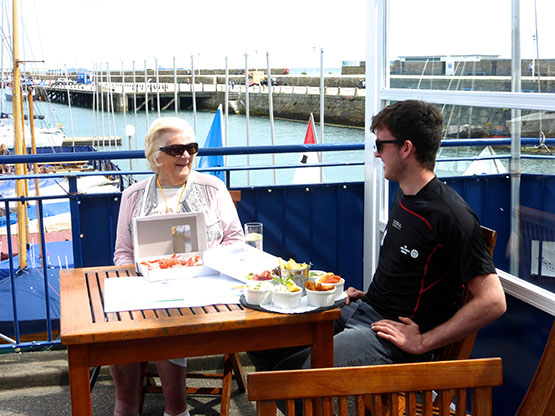
In his quiet but determined way, Johnny Hooper - with his own Olympic credentials and more championship wins than you could list on one page - was able to persuade his fellow NYC members to take positive action for juniors, and continue to keep taking that positive action. For it can be easy enough to start things. It’s keeping the programme going and growing, with rising standards all the time, that differentiates the exceptional setup from the merely run-of-the-mill. The Hooper inspiration has endured and thrived. But it was only when the year of its inception happened to be mentioned that the radar flashed up: Golden Jubilee in 2017.
Regardless of what happens at the Olympics, there certainly will be something to celebrate next year. But for the next few weeks, any notions of such celebrations will be on the most remote back burner, as the entire club - and indeed all of Irish sailing - will be on Olympic high alert.
We’ll share a state of nervous anticipation as the quadrennial five ring circus unfolds afloat amidst the unrivalled beauty and unique sea water quality of Rio de Janeiro. And somewhere in the midst of it all, attention will be particularly focused on the youngest sailor ever to represent Ireland in the Olympic, a 20-year-old from an utterly rural part of County Carlow whose very young demonstrations of special talent soon saw him being inducted into the bigger world of National Yacht Club’s Junior Section, and also provided him – thanks to that special NYC spirit - with essential financial support in the crucial year of moving from junior to adult level.
Finn Lynch at 20 years and three months will not only be the youngest sailor ever to represent Ireland in the Olympics, he’ll actually be a couple of months younger than the notably young Paul Elvstrom of Denmark when he began his stellar career back in 1948, an achievement which set a benchmark for youthful Olympic sailing participation.
 Finn Lynch is welcomed home at the NYC after qualifying for Rio. At 20 years and three months, Finn will be Ireland’s youngest-ever Olympic sailor. Photo: W M Nixon
Finn Lynch is welcomed home at the NYC after qualifying for Rio. At 20 years and three months, Finn will be Ireland’s youngest-ever Olympic sailor. Photo: W M Nixon
But as Lynch only snatched Ireland’s Olympic Men’s Laser place as recently as May 18th on the last race in the last chance in Mexico, the sailing community are still getting to grips with the fact that a rising talent, who had been showing great promise to be the ideal representative in Tokyo in 2020, has already come centre stage to begin his Olympic career in Rio 2016.
The story of how this has come about for Finn is circuitous and distinctly offbeat, yet ultimately very Irish. But if you suggested the outline of it to a movie producer as a possible film treatment, you’d probably be told it’s so over the top that audiences would refuse to accept it. All that can be said is that if it isn’t true, then somebody should make it up, as it’s too good a story to waste.
His father Aidan Lynch is of a midlands family, and though his boyhood was in Dublin, much time was still spent down the country, but boats had absolutely nothing to do with it. His mother Grainne Adams is from rural Carlow, that small county which is so beautiful that it has been rightly remarked the Creator was in fine form when he put it together.
However, neither Carlow nor Dublin offered the young couple the prospects they sought, so they emigrated to Australia. There, Aidan found much better career opportunities, and it was during his time as a rising star in the manufacturing world that he was taken on a corporate sailing outing. He was instantly hooked, and made it his spare-time business to learn about sailing and get involved with it as soon and as much as possible.
In Australia their three sons Ben, Rory and Finn were born, but after twelve years – when Finn was just two – the Australian sojourn came to and end, and Grainne was able to return to her beloved Carlow, to Benekerry which is just about as rural as it is possible get in a very rural county. But Aidan hankered after his sailing, and got involved in the nearest club, Blessington on its lovely reservoir lake just up the road in County Wicklow. In time, Blessington became his home while Grainne continued in Benekerry, and for their three boys, time with Dad saw sailing playing an increasing role. While Ben and Rory were already rising stars in the Blessington Topper sailing scene, it was when Finn had his first sail in charge of a Topper at the age of eight on Blessington Lake that history was made.
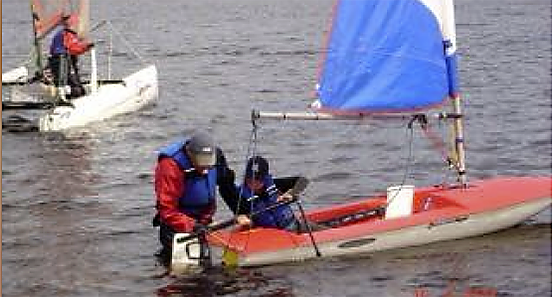 The first sail - his father Aidan introduces the 8-year-old Fnn Lynch to Topper steering in Blessington Lake
The first sail - his father Aidan introduces the 8-year-old Fnn Lynch to Topper steering in Blessington Lake
He’d already shown a complete fascination with everything to do with boats and sailing. Big brother Ben was showing additional talent as a coach, and when he ran classes in the Blessington SC clubhouse, he was at first disconcerted to see his kid brother Finn perched under the front table, bright-eyed and determinedly absorbing every snippet of boat and sailing information that came his way.
Blessington was one of the foremost clubs in the country in promoting the use of the Topper in junior sailing. But although this weekend will see the largest Irish entry ever in the 250-strong Topper Worlds which are getting under way in Ballyholme – last count had the home group pushing toward the 85 mark - only twelve years ago, the economical Topper still had a certain amount of persuading to do in order to get acceptance in Ireland.
Yet those were good times when they were building the class, and Aidan Lynch happily recalls the spirit of camaraderie and shared purpose which energised the steadily growing “Topper family” in Ireland, creating friendships which were rekindled when former Topper colleagues from all over Ireland shared in Finn Lynch’s successes.
For although he may not have started properly sailing until he was eight, in his case it seems to have been the right time, and by the age of 12 in 2008 he had been selected for the ISA Topper Squad in which he developed so rapidly that in 2009 he took the Silver Medal at the Topper Worlds in Austria.
He was still sailing with Blessington, but with the prospect of Laser sailing with the National YC coming up on the agenda, he moved his focus to Dublin Bay and by 2011 was selected for the ISA Academy. The ISAF Youth Worlds in Dublin Bay in 2012 were perfectly timed for his developing talents, where he won the Silver Medal, and added the Under 17 European Laser Radial title to his trophy list, while in 2013 he was Under 21 Laser Radial World Champion, winning the Bronze in the Open Division.
 The Laser might have been designed with Finn Lynch in mind
The Laser might have been designed with Finn Lynch in mind
 Into his stride. Finn Lynch in command, Dublin Bay 2012
Into his stride. Finn Lynch in command, Dublin Bay 2012
The Under 19 Laser World Champion title followed in 2014, while in 2015 he was fourth in the Under 21 Laser Worlds. But now at age 18 he was no longer a junior, yet was very much in that limbo stage in which Irish sailing seems to place talent which is no longer junior, but is still definitely not adult. It’s an undesirable state of affairs, yet with ISA resources under enormous pressure, it was not a problem which was going to be solved by the National Authority in 2015.
The 18-year-old Finn Lynch found himself right at the heart of this dead end, needing backing which was beyond family resources, but in any case frustrated at not being able to make his own way in a true spirit of growing independence. He had impressed everyone with his talent, his coolness under pressure and his sheer dedication to the sport, but a quantum leap in resources was needed to see him across the gap from family support under the ISA junior umbrella, and on into the challenging world of adult sailing based on an adequate budget.
In the Spring of 2015 Carmel Winkelmann, a strength of the National Yacht Club and particularly its junior section for longer than anyone can remember, was already working quietly behind the scenes to find support for what she reckoned was a great talent at risk of going to waste. After consulting with Finn about the events he’d particularly like to do in the year ahead and the international coaches whose talents he’d like to use, it was reckoned that with the most careful expenditure it could be done for €40,000, and that was the target Carmel had set herself by June 2015.

She’s a formidable woman when she thinks a real noise has to be made about some boat issue, but she’s much more formidable when she takes the approach of working quietly behind the scenes to achieve her objective. Her Finn Lynch fund-raising was done under the very sensible approach that good works are best done by stealth, and the money-raising was mainly through a small but impressive list of private subscribers.
I met Finn in June 2015 when there was still a considerable element of the unknown and the unknowable about it all, and then I met him again at the end of June this year when his Olympic place was secured against all the odds, and the story of what had happened in between was in keeping with the extraordinary story of how he and his brothers came to be keen sailors in the first place.
For the past year, his life has been a mobile existence. While Carmel Winkelmann and her team had to come up with all the resources to keep the Lynch show on the road, James O’Callaghan the ISA Performance Director was able to come up with the introductions to the top coaches in Croatia whose special talents fit well with the Irish sailing model. Nevertheless, even with all the support and good wishes being drummed up under the NYC umbrella, it was still a lonely enough existence for the 19-year-old Carlow lad to take himself off to southeast Europe and be the youngest in an intense training squad which lived and breathed Laser racing, but they lived and breathed it in languages other than English.
His first introduction to the notably successful Croatian training programmes was with Milan Vujasinovic, who as Finn recalls, “turned us into sailors and into men”. Then through dogged persistence, and maybe a bit of blarney, he managed to get himself taken into the elite group under the tutelage of the “medals coach”, Jozo Jakelic, who is a legend in the training world.
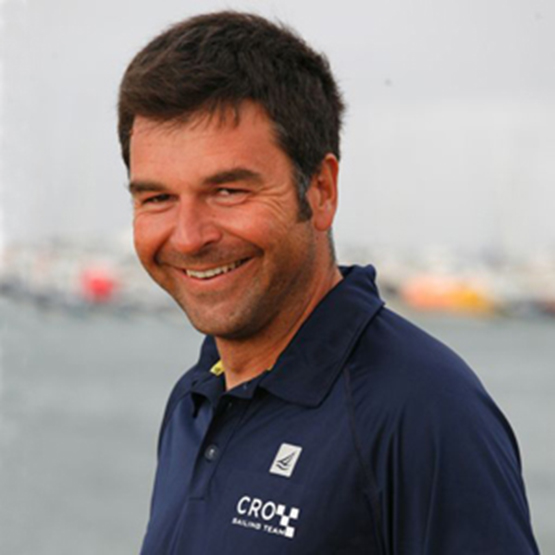 Coach to the stars….Croatia’s Jozo Jakelic has seen all five of his elite international squad gain an Olympic place at Rio
Coach to the stars….Croatia’s Jozo Jakelic has seen all five of his elite international squad gain an Olympic place at Rio
It’s a status he thoroughly deserves, for all of his special squad of five Laser sailors have secured their country’s Olympic places for the Rio games. Jakelic is bringing stardust to countries which would formerly have been thought of as being on the fringes of world sailing, paces like Cyprus and Poland and Ireland too, for let’s face it, despite having one of the longest sailing histories of any country in the world, in international competition terms Ireland is on the fringe.
Thus you could argue that Finn Lynch was on the fringe of the fringe group, for at 19 he was much the youngest of the Jakelic squad – the next up was 25. Yet he kept at it, keeping up a ferocious regime in which, when not in competition, you still expect to be doing a lot of sailing on at least fifteen days in very month, while gym work towards ultimate fitness is just a normal part of life all the time.
 The pressure is on. Finn Lynch during the long battle to secure the Olympic place
The pressure is on. Finn Lynch during the long battle to secure the Olympic place
Yet in this rarefied and almost monastic atmosphere, progress was being made, but there were setbacks. Last November, while out on an intensive session on a training bike, Finn Lynch had an accident which left him with a badly damaged shoulder. At one stage it was thought surgery would be necessary, but thanks to high-powered physio with Sports Med in Dublin, he was just about able to compete, albeit with an impaired performance, at the Copa de Brasil in Rio.
One of his concerns would be that this accident would discourage his group of private supporters. But on the contrary, if anything it spurred them onto to greater efforts and a determination that he would see the programme through to leave him, at the very least, in a good condition and in a good place to begin the serious countdown to Tokyo 2020, buoyed up by the knowledge that an entire year hadn’t been allowed to go to waste.
Certainly for most observers it seemed very much an outside chance that Lynch would manage to take the Irish place through the final qualifier, the Laser Worlds in Mexico in May 2016. But the Finn Lynch who arrived at the Worlds was a different Finn Lynch from the damaged athlete who had been unable to give of his best in Brazil. And he was a whole world away from the still-to-prove himself young adult who had been in Dun Laoghaire in June 2015.
It didn’t start well in Mexico, as he’d picked up a virus which sapped his strength. But he seemed to shake it off through sheer will-power, and put in a performance of almost superhuman focus to do the job. Finn Lynch secured that Irish Laser place in the Rio Olympics in a last ditch stand on May 18th 2016, and it’s no exaggeration to say that at a stroke his lifepath had been changed.
We’ve a problem in Ireland in that getting an Olympic selection is seen as such a goal in its own right that for some athletes, it seems to be the main goal – what happens in the actual Olympics becomes almost irrelevant. But that’s not a mindset which is going to take hold in a member of Jozo Jakelic’s squad, so for a while after the Mexican breakthrough, Finn Lynch chilled out in Norway with his girlfriend and her family (she’s a Laser sailor too) and then spent private time in Ireland – continuing training all the time – until an informal gathering was organized through Carmel Winkelmann. This was in late June at the National YC where the new Olympic star was to meet again with Afloat.ie, and also put through a well-received interview with Clair McNeill of the “Carlow County Matters” magazine programme on Irish TV Sky 191, for in Carlow - even more than in Dun Laoghaire - a new Olympic star is big news.
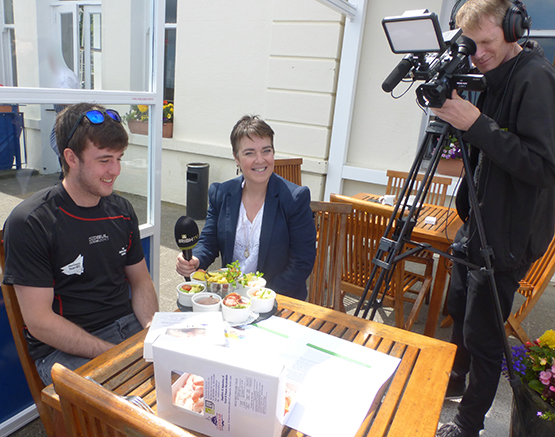
As almost exactly a year had elapsed since I’d met him with his then only resource, a van which might well have served from time to time as overnight accommodation, it was fascinating to try to make comparisons between the more confident young man of today and that much younger hopeful of 2015.
For sure he was more of an impressive and confident presence, but essentially he was still the same Finn Lynch, but with the best bits made even better, and an underlying steely determination now getting towards something even tougher.
But don’t think for a moment that the traiming programme organized through the funding raised by Carmel Winkelmann resulted in him becoming a pampered athlete. There were times when he had to make do with the most basic and often very shared accommodation, while the budget was always tight. But the fact that he was a member of the squad which was the elite of the elites – albeit very much the youngest member of that squad in Croatia – has been transformational.
In a sense it has made him supra-national. The esprit de corps in the Jakelic squad is something which raises pure sailing athleticism above national ambitions and aspirations. Indeed, at a time when the European ideal is taking such a battering, the very existence of such a group made of rising sailing stars from the fringes of Europe is somehow very heartening. Thus the experiences of Finn Lynch during the past twelve months have an added and encouraging resonance for all of us.
Nevertheless, back home the securing of that Olympic place is yet another specific success for the NYC’s Junior Sailing, and Commodore Larry Power and his team treated us to a cheerful bar lunch before everyone went on their way, your reporter off to Wicklow to re-immerse himself in covering the Round Ireland Race, and Finn Lynch soon on his way back to Croatia and further intense yet carefully monitored training sessions to transform him from an aspirant to a contender.
That little gathering in the National YC marked the end of a phase. It quietly concluded Carmel Winkelmann’s fund-raising for Finn Lynch. She was able to provide resources in a hurry when they were urgently needed, and she was able to pass on messages of hundred per cent support from her team when things seemed to be going pear-shaped during the winter.
But now that Finn has shown independently what he can do, it’s time to turn to more orthodox lines of support, and his father has been working behind the scenes to see about putting it all on a more businesslike basis.
Inevitably, just how that all takes shape will depend to some extent on how things go in Rio, but we can only hope that a more mature attitude can be found among the rest of us. Success in Rio would certainly be a bonus, but really we should be thinking about Tokyo 2020, and simply being in contention in Rio is unrivalled experience for Japan in four years time.
Since the end of June Finn Lynch had been back in Croatia, but this week he returned to Ireland to give logistics support to the Croatian squad in the Laser Radial Worlds in Dun Laoghaire. Coaching and encouragement seem to be in the Lynch family blood – after our meeting in June, he’d set that evening aside for a special session of personal coaching for his brother Ben’s training group, and Finn will not be the only Lynch in Rio – Ben is coach to Ireland’s John Twomey and his Paralympic crew. We wish them all the very best of luck. Irish Olympic sailing turns up some remarkable stories, and this is surely one of the most remarkable of all.
Preparing to Race At Rio's Olympic Sailing Regatta
As in most yacht races, the general terms for the Olympic Regatta are set out in a Notice of Race (NoR) while the details are covered by the Sailing Instructions (SIs). Both of these have been published and are available on the World Sailing Website www.sailing.org. Like many NoRs and Sis, other documents are referenced - in the case of the Olympic Regatta there are Equipment, Competitions Area and Support Team regulations, while athletes are also bound by a Media Guide. Overarching all these are the comprehensive agreements that athletes enter into with the International Olympic Committee through their National Olympic Committees.
These documents will come under intense scrutiny, not just by sailors and their support teams as part of their normal preparation, but also by the team of officials that will be engaged in ensuring a fair competition both ashore and afloat.
For most of the sailors at this level, there should be no major surprises in the sailing instructions as they will have used these or a version of these in qualifying events, World Cups and Major Championships.
Let us catch up with an imaginary sailor as they prepare to go afloat. Their base is Marina Da Gloria in Guanabara Bay, in what is Rio's middle harbour. While waiting for flag D - the signal that they can go afloat - many sailors will first apply barrier creams to protect against sun and bacteria. Then they will visit the Omega cabin to deposit their accreditation and to collect their tracking module which they will affix to the boat so that we can follow their race progress. Once flag D is up they will proceed to their designated course area, taking care not to stray out of the competition area while also remaining clear of other course areas and official boats. Infractions of any of these area controls may incur a penalty.
Once at their designated course area, things become fairly standard for them, although not every observer will be familiar with the sound signals guns every minute in the countdown that are now used at this level. This table explains the sequence our sailor will encounter:
| Minutes Before Starting Signal | Visual Signal Displayed | Visual Signal Removed | Sound Signal | Means |
| 6 | Class flag, P or starting penalty flag (U, or Black flag) if required O flag if applicable | Class to start Starting penalty RRS P5 (RRS 42) | ||
| 5 | White flag with number 5 | One | Warning signal | |
| 4 | Blue flag with number 4 | White flag | One | Preparatory Signal |
| 3 | Pink flag with number 3 | Blue Flag | One | Three minutes |
| 2 | Red flag with number 2 | Pink Flag | One | Two minutes |
| 1 | Yellow flag with number 1 | Red Flag | One | One minute |
| 0 | Green flag | Yellow flag | One | Start signal |
| +1 | Green flag and Class flag, U or Black and O. | No Sound |
The format consists of an opening series of up to 12 races (12 in Skiffs and Windsurfers, 10 in everything else) with a maximum of three races per day and a final medal race between the top ten in each fleet after the opening series.
Thus our sailor can expect up to three consecutive races, although if the schedule is maintained it is more likely to be two a day.
While the courses are generally windward/leeward or trapezoid, there are some variations afforded to the race officer, such as final slaloms (possibly windsurfers only), inner or outer trapezoids and different finishing directions for windward/leeward courses.
Rio's location, with a large bay and open ocean close by, offers a considerable variety of course areas and seven have been designated across the three distinct areas of Inner Harbour, Middle Harbour and Ocean. Several of these offer shore viewing and all, except maybe one of the ocean courses, will be considerably influenced by the presence of the land.
Our sailor will need to be wise to the designated course for the day, and once there, will need to be keep their head out of the boat to recognise the influences exerted by wind and current on their course.
At the end of racing the sailor returns to Marina da Gloria where an extensive cleansing of boat, equipment, clothing and bodies will follow. The anti-doping team will be randomly selecting sailors for testing and once over this hurdle sailors can pick up their accreditation while returning the tracker before catching the shuttle to the Olympic Village.



























